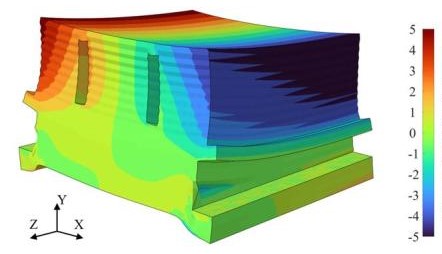
Which input parameters matter most for 3D printing simulation?
Given the typical cost and time involved in industrial 3D printing applications, a.k.a. additive manufacturing (AM), simulation is an invaluable tool for ensuring a successful 3D print. By simulating the thermal and mechanical phenomena involved in additive processes, engineers can lessen the need for trial-and-error experimentation with various materials and settings, optimizing both 3D printing time and material usage.
However, there are dozens, if not hundreds, of potential input parameters to consider when it comes to AM simulation, including not only materials and part designs but also the specific settings of the 3D printer itself. This article covers the essential considerations involved in machine-specific input parameters for additive manufacturing simulation.
Material considerations in 3D printing simulation
At the most general level, any simulation of 3D printing needs to be process-specific. While there are some common parameters across various processes, such as laser power, the specific values involved are still ultimately determined by the particular process and machine at hand. In general, AM simulations can be divided in terms of process by the materials involved:
- Thermoplastic parts made using selective laser sintering (SLS), fused filament fabrication (FFF), etc.
- Resin parts made using stereolithography (SLA), digital light processing (DLP), etc.
- Metal parts made using laser powder bed fusion (PBF), directed energy deposition (DED), etc.
Each of these material/process pairs comes with its own set of machine-specific considerations for simulation, with the number of relevant input parameters varying accordingly. Broadly speaking, metal additive manufacturing is the most complex, with the largest number of input parameters and, for that reason, the rest of this article will focus on metal AM specifically.
Process considerations in metal AM simulation
While there are a variety of processes for 3D printing metal components, including not only PBF and DED but binder jetting (BJ), ultrasonic consolidation (UC) and even FFF, PBF and DED are by far the most common. As indicated in the previous section, the difference between these processes make a difference to the input parameters for simulation. For example, in metal powder bed processes, engineers will typically use calibrated strain libraries to enable relatively fast computations of part distortions. However, these libraries tend to be specific to a machine type, or even to a particular machine.
Other machine-specific parameters include laser power, scan speed, layer thickness and path offsets. One of the reasons for the differences between PBF and DED simulation inputs is in the energy sources involved in each process. The former uses laser scanning optics directed by magnetically driven mirrors using galvanometers, which generally makes it faster than DED, where moving the entire mass of a laser head is subject to delays during hard acceleration or deceleration and requires rigid and complex mechanical systems to maintain speed and accuracy.
In fact, NIST has created a reference activity model for additive manufacturing, with a focus on powder bed fusion, but simulation is explicitly beyond its scope, most likely due to the variability between AM machines as well as materials.
Machine-specific parameters for metal AM simulation
Creating a library of machine-specific characteristics can help reduce the computational expense of AM simulation, as indicated in the example above with calibrated strain libraries for PBF. Examples of relevant machine characteristics include:
- Laser parameters
- Build chamber parameters
- PBF parameters
- Recoat thickness uniformity
- DED parameters
The above parameters constitute a small but significant proportion of the relevant machine-specific input parameters for metal AM simulation. For more information on a particular machine, be sure to consult with your supplier.





